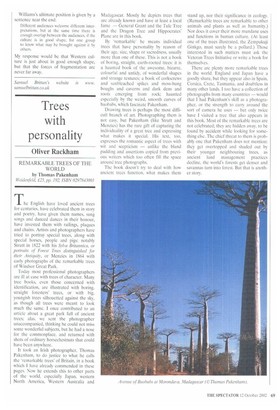Trees with personality
Oliver Rackham
REMARKABLE TREES OF THE WORLD by Thomas Pakenham Weidenfeld, £25, pp. 192, ISBN 0297843001 The English have loved ancient trees for centuries, have celebrated them in story and poetry, have given them names, sung songs and danced dances in their honour, have invested them with railings, plaques and chains. Artists and photographers have tried to portray special trees, along with special horses, people and pigs: notably Strutt in 1822 with his Sylva Britannica, or portraits of Forest Trees distinguished for their Antiquity, or Menzies in 1864 with early photographs of the remarkable trees of Windsor Great Park.
Today most professional photographers are ill at ease with trees of character. Many tree books, even those concerned with identification, are illustrated with boring, straight foresters' trees, or with big, youngish trees silhouetted against the sky, as though all trees were meant to look much the same. I once contributed to an article about a great park full of ancient trees; alas, we sent the photographer unaccompanied, thinking he could not miss some wonderful subjects, but he had a nose for the commonplace, and returned with shots of ordinary horsechestnuts that could have been anywhere.
It took an Irish photographer. Thomas Pakenham, to do justice to what he calls the 'remarkable trees' of Britain, in a book which I have already commended in these pages. Now he extends this to other parts of the world. especially Japan, western North America, Western Australia and Madagascar. Mostly he depicts trees that are already known and have at least a local fame — General Grant and the Tule Tree and the Dragon Tree and Hippocrates' Plane are in this book.
By 'remarkable' he means individual trees that have personality by reason of their age, size, shape or sacredness, usually more than one of these. This is not a book of boring, straight, earth-rooted trees: it is a haunted book of the awesome, bizarre, colourful and untidy, of wonderful shapes and strange textures; a book of corkscrew's and sunbleached spikes and moss-hung boughs and caverns and dark dens and roots emerging from rock; haunted especially by the weird, smooth curves of baobabs, which fascinate Pakenham.
Drawing trees is perhaps the most difficult branch of art. Photographing them is not easy, but Pakenham (like Strutt and Menzies) has the rare gift of capturing the individuality of a great tree and expressing what makes it special. His text, too, expresses the romantic aspect of trees with wit and scepticism — unlike the bland padding and assertions copied from previous writers which too often fill the space around tree photographs.
The book doesn't try to deal with how ancient trees function, what makes them stand up, nor their significance in ecology. (Remarkable trees are remarkable to other animals and plants as well as humanity.) Nor does it cover their more mundane uses and functions in human culture. (At least one of the trees illustrated, the Zempukuji Ginkgo, must surely be a pollard.) Those interested in such matters must ask the Veteran Trees Initiative or write a book for themselves.
There are plenty more remarkable trees in the world. England and Japan have a goodly share, but they appear also in Spain. Corsica, Crete, Tasmania, and doubtless in many other lands. I too have a collection of photographs from many countries — would that I had Pakenham's skill as a photographer, or the strength to carry around the sort of camera he uses — but only twice have I visited a tree that also appears in this book. Most of the remarkable trees are not celebrated; they are hidden away, to be found by accident while looking for something else. The chief threat to them is probably one that Pakenham does not mention: they get overtopped and shaded out by their younger neighbouring trees, as ancient land management practices decline, the world's forests get denser and savannas turn into forest. But that is another story.


































































































 Previous page
Previous page